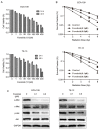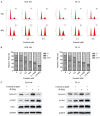Foretinib Enhances the Radiosensitivity in Esophageal Squamous Cell Carcinoma by Inhibiting Phosphorylation of c-Met
- PMID: 28529610
- PMCID: PMC5436250
- DOI: 10.7150/jca.18135
Foretinib Enhances the Radiosensitivity in Esophageal Squamous Cell Carcinoma by Inhibiting Phosphorylation of c-Met
Abstract
As a crucial event involved in the metastasis and relapse of esophageal cancer, c-Met overexpression has been considered as one of the culprits responsible for the failure in patients who received radiochemotherapy. Since c-Met has been confirmed to be pivotal for cell survival, proliferation and migration, little is known about its impact on the regulation of radiosensitivity in esophageal cancer. The present study investigated the radiosensitization effects of c-Met inhibitor foretinib in ECA-109 and TE-13 cell lines. Foretinib inhibited c-Met signaling in a dose-dependent manner resulting in decreases in the cell viability of ECA-109 and TE-13. Pretreatment with foretinib synergistically prompted cell apoptosis and G2/M arrest induced by irradiation. Moreover, decreases ability of DNA damage repair was also observed. In vivo studies confirmed that the combinatorial use of foretinib with irradiation significantly diminishes tumor burden compared to either treatment alone. The present findings implied a crucial role of c-Met in the modulation of radiosensitization in esophageal cancer, and foretinib increased the radiosensitivity in ECA-109 and TE-13 cells mainly via c-Met signaling, highlighting a novel profile of foretinib as a potential radiosensitizer for the treatment of esophageal cancer.
Keywords: Esophageal cancer; Foretinib; Radiosensitivity; c-Met.
Conflict of interest statement
Competing Interests: The authors have declared that no competing interest exists.
Figures






Similar articles
-
Foretinib induces G2/M cell cycle arrest, apoptosis, and invasion in human glioblastoma cells through c-MET inhibition.Cancer Chemother Pharmacol. 2021 Jun;87(6):827-842. doi: 10.1007/s00280-021-04242-0. Epub 2021 Mar 10. Cancer Chemother Pharmacol. 2021. PMID: 33688998
-
HER2 Confers Resistance to Foretinib Inhibition of MET-Amplified Esophageal Adenocarcinoma Cells.Ann Thorac Surg. 2018 Feb;105(2):363-370. doi: 10.1016/j.athoracsur.2017.09.003. Epub 2017 Dec 7. Ann Thorac Surg. 2018. PMID: 29223420
-
Cetuximab enhances radiosensitivity of esophageal squamous cell carcinoma cells by G2/M cycle arrest and DNA repair delay through inhibiting p-EGFR and p-ERK.Thorac Cancer. 2023 Aug;14(22):2127-2138. doi: 10.1111/1759-7714.14995. Epub 2023 Jun 20. Thorac Cancer. 2023. PMID: 37337933 Free PMC article.
-
Combination effect of lapatinib with foretinib in HER2 and MET co-activated experimental esophageal adenocarcinoma.Sci Rep. 2019 Nov 26;9(1):17608. doi: 10.1038/s41598-019-54129-7. Sci Rep. 2019. PMID: 31772236 Free PMC article.
-
[Effects and its mechanism of Nimotuzumab on radiosensitivity of esophageal carcinoma ECA-109 and TE-13 cell lines].Zhonghua Zhong Liu Za Zhi. 2016 Oct 23;38(10):732-738. doi: 10.3760/cma.j.issn.0253-3766.2016.10.004. Zhonghua Zhong Liu Za Zhi. 2016. PMID: 27784455 Chinese.
Cited by
-
Combination Foretinib and Anti-PD-1 Antibody Immunotherapy for Colorectal Carcinoma.Front Cell Dev Biol. 2021 Jul 8;9:689727. doi: 10.3389/fcell.2021.689727. eCollection 2021. Front Cell Dev Biol. 2021. PMID: 34307367 Free PMC article.
-
MET overexpression and intratumor heterogeneity in esophageal squamous cell carcinoma.Braz J Med Biol Res. 2021 May 24;54(8):e10877. doi: 10.1590/1414-431X2020e10877. eCollection 2021. Braz J Med Biol Res. 2021. PMID: 34037097 Free PMC article.
-
Foretinib induces G2/M cell cycle arrest, apoptosis, and invasion in human glioblastoma cells through c-MET inhibition.Cancer Chemother Pharmacol. 2021 Jun;87(6):827-842. doi: 10.1007/s00280-021-04242-0. Epub 2021 Mar 10. Cancer Chemother Pharmacol. 2021. PMID: 33688998
-
Norcantharidin alone or in combination with crizotinib induces autophagic cell death in hepatocellular carcinoma by repressing c-Met-mTOR signaling.Oncotarget. 2017 Dec 4;8(70):114945-114955. doi: 10.18632/oncotarget.22935. eCollection 2017 Dec 29. Oncotarget. 2017. PMID: 29383132 Free PMC article.
-
Potential Molecular Targets in the Setting of Chemoradiation for Esophageal Malignancies.J Natl Cancer Inst. 2021 Jun 1;113(6):665-679. doi: 10.1093/jnci/djaa195. J Natl Cancer Inst. 2021. PMID: 33351071 Free PMC article. Review.
References
-
- Ajani JA, D'Amico TA, Almhanna K. et al. Esophageal and esophagogastric junction cancers, version 1.2015. J Natl Compr Canc Netw. 2015;13:194–227. - PubMed
LinkOut - more resources
Full Text Sources
Other Literature Sources
Research Materials
Miscellaneous

